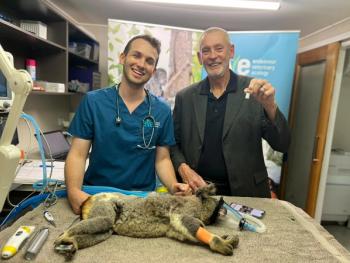
New studies in veterinary internal medicine: Bacterial infections
The latest information on bacterial contamination of fluid bags and ports, plus new tests for leptospirosis.
Bacterial infections should concern any veterinarian, particularly if they are caused iatrogenically. Recent studies, briefly described below, found only minor levels of contaminations in reused intravenous fluid bags but more on ports after several days. And new in-clinic tests for leptospirosis show promise.
GETTY IMAGES/Kevin MayerIntravenous fluid bag colonization
Although we all know it's a less-than-ideal practice, many of us still keep a bag of fluids that we periodically reuse. In some cases these bags are used for subcutaneous fluid therapy in multiple patients or in the same patient (a relatively common practice in cats with chronic kidney disease for which the owners administer the fluids at home).
Of course, when the bag is punctured to obtain fluids, there's always the risk of bacterial contamination. Indeed, studies show that contamination can occur in veterinary multiuse medication vials. One study found that 18% of multidose vials at a veterinary teaching hospital were contaminated with bacteria, in some cases with organisms that clearly were pathogenic.1 This study also cultured saline bottles and found that over a third contained bacteria.
Researchers from The Ohio State University looked for bacterial contamination of fluid bags in a veterinary emergency room (ER) and intensive care unit (ICU). The researchers used 1-L bags of saline (n=90) punctured three times daily. Samples were cultured on days 0, 2, 4, 7 and 10.2 The bags in the ER showed no bacterial growth on days 0 or 2. On day 4, 1.1 percent of the bags had positive test results for bacteria, and on days 7 and 10, 4.4 percent had positive results. None of the bags in the ICU were positive at any time point.
The injection ports were also sampled with a swab, and the following bacterial growth was found:
> Day 0: 4.4 percent
> Day 2: 12.2 percent
> Day 4: 17.8 percent
> Days 7 and 10: 31.1 percent
Most contaminated ports were in the ER.
The results of this study, which were presented at the 2013 International Veterinary Emergency and Critical Care Symposium, suggest that bacterial contamination of fluid bags used over a longer period is rare but does occur. If the bag is used for only two days, the risk of contamination appears to be low. Infection of fluid bags may be linked to the severity of port contamination.
A previous study showed that if an alcohol swab was used before inserting a needle into a port, the introduction of bacteria into the vial was significantly reduced.1 This study also demonstrated a much higher prevalence of bacterial contamination in bottles of saline solution.
The differences in the results of these two studies may be related to environmental differences in which the bags were used. It's possible that the ER or ICU staff paid close attention to hand hygiene and suitable practices when taking fluids from a bag, something that may not occur in a less-intense practice environment.
The takeaway: Although not an ideal practice, multiple uses of intravenous fluid bags is feasible, although attention should be paid to appropriate port disinfection before removal of fluids, and the bag should be discarded after two days.
GETTY IMAGES/GlobalPLeptospirosis
In some geographic areas, leptospirosis is a leading cause of kidney disease in dogs. The resurgence of this pathogen has occurred as a result of disease caused by serovars other than Leptospira interrogans serovar canicola or Leptospira icterohaemorrhagiae, which had previously been the most common serovars associated with clinical disease in dogs.
Another concern is that leptospirosis is potentially zoonotic, and veterinary healthcare team members can be exposed to the organism through contact with urine from infected dogs. In one study, blood was taken from 511 veterinarians who attended the 2006 American Veterinary Medical Association convention and assayed for various Leptospira serovars using a microscopic agglutination test (MAT). Of the veterinarians tested, 2.5 percent had positive test results, with the most common serovar being Leptospira bratislava.3
Generally, any dog that presents for acute renal failure should be treated as a leptospirosis suspect, and appropriate precautions (e.g., gloves, hand washing) should be taken until the dog can be tested, even though it can take several days to get results. Many dogs are subclinical carriers.
In a study done in Michigan and prior to the introduction of the newer vaccines, almost 25 percent of otherwise healthy dogs had titers that suggested exposure to leptospirosis, especially serovars L. grippotyphosa and L. bratislava.4
Vaccine versus natural exposure. One of the diagnostic challenges of leptospirosis is determining if an elevated titer on an MAT test is from vaccine or natural exposure. Although various cutoffs have been proposed, it's still a challenging task.
A study from Colorado State University, the results of which were presented at the 2013 American College of Veterinary Internal Medicine (ACVIM) Forum, investigated the impact of vaccination on MAT titers.5 Twenty-three healthy dogs were given one of four vaccines that contained L. canicola, L. grippotyphosa, L. pomona and L. icterohaemorrhagiae serovars. They had received two doses of the same vaccine about a year previously. Blood samples were collected before vaccination and four weeks later.
After one year, 20 of the 23 dogs had negative test results for MAT titers. Four weeks after vaccination, about 50 percent of the dogs had an MAT titer ≥ 800 for at least one serovar. The vaccines have undergone duration of immunity studies showing efficacy at protecting against disease one year after vaccination. A markedly elevated titer, even in a vaccinated dog, probably indicates natural exposure, unless the vaccination was given recently.
A new in-clinic test. Another major issue with testing for leptospirosis is that the MAT generally has to be done at a reference laboratory, and it may take several days before results become available. PCR tests are available for testing blood or urine for leptospirosis antigens, but again, it may take time to get results back. IDEXX Laboratories recently started offering an ELISA based on detection of antibodies to LipL32. This protein is present only on pathogenic Leptospira species.
At the 2014 ACVIM Forum, a study was presented that looked at an in-clinic version of this test.6 The researchers looked at 403 serum samples that were submitted for MAT testing. Of the samples, 202 were positive (MAT titer ≥ 800), and 201 were negative based on MAT. Sensitivity was 83 percent, and specificity was 82 percent. This means that of the 201 positive results, the test picked up on 168 of them. Specificity refers to true positives, so 82 percent of the cases that were positive on the in-clinic test were positive on the MAT; 18 percent were false positives.
One issue with these statistics is that an MAT titer ≥ 800 was considered positive. Some of the cases that were positive on the in-clinic test may have had titers on MAT, just not ≥ 800. The investigators also looked at 150 sera from dogs in the state of Alaska in which the disease essentially doesn't exist. In this case only 4 percent false positives were found.
These results are quite promising. The test isn't 100 percent with regard to sensitivity or specificity, but it is pretty good, and the major benefit is that it can be run in the clinic immediately.
The takeaway: Given the results of this study, I would consider a positive result on the test highly suspicious, and if the clinical signs fit, I would handle the patient as if it had leptospirosis. I probably would continue to use appropriate infection-control procedures if the patient had negative results on the in-clinic test, simply because of the risk to people, but I would be a bit less concerned. Of course, the in-clinic test doesn't replace the MAT or PCR test in diagnosing this disease. But provided it becomes commercially available, it does offer a rapid in-house test with relatively accurate and helpful results.
References
1. Sabino CV, Weese JS. Contamination of multiple-dose vials in a veterinary hospital. Can Vet J 2006;47(8):779-782.
2. Guillaumin J, Olp N, Magnusson K, Butler A, Daniels J. Influence of hang time on bacterial colonization of intravenous bags in a veterinary emergency and critical care setting (abst). J Vet Emerg Crit Care 2013;23:S6.
3. Whitney EA, Ailes E, Myers LM, et al. Prevalence of and risk factors for serum antibodies against Leptospira serovars in US veterinarians. J Am Vet Med Assoc 2009;234:938-944.
4. Stokes JE, Kaneene JB, Schall WD, et al. Prevalence of serum antibodies against six Leptospira serovars in healthy dogs. J Am Vet Med Assoc 2007;230:1657-1664.
5. Wennogle SA, Curtis, K, Chandrashekar R, et al. Vaccine-associated Leptospira antibody responses in client-owned dogs after a one year booster. J Vet Intern Med 2013;27(3):724-725.
6. Curtis K, Foster P, Smith P, et al. Performance of an in-clinic ELISA for the detection of Leptospira specific antibody in dogs (abst). J Vet Intern Med 2013;28:1066.
Anthony P. Carr, Dr. med. vet., DACVIM, is a professor of small animal clinical sciences at Western College of Veterinary Medicine, University of Saskatchewan.
Newsletter
From exam room tips to practice management insights, get trusted veterinary news delivered straight to your inbox—subscribe to dvm360.






